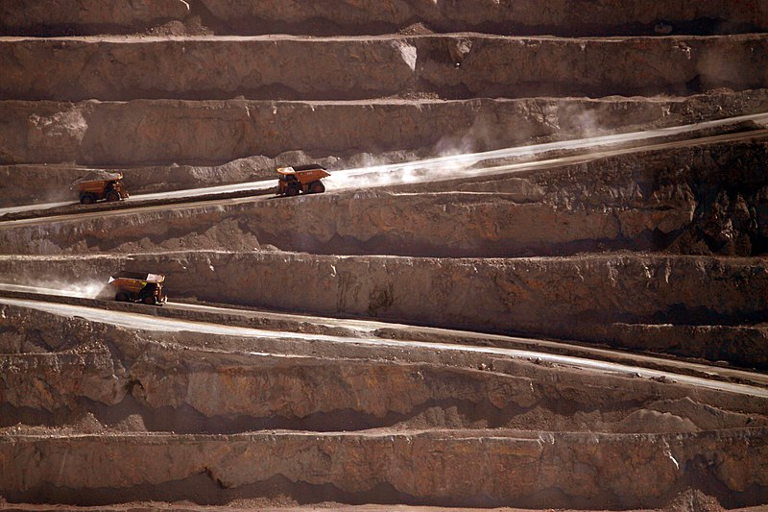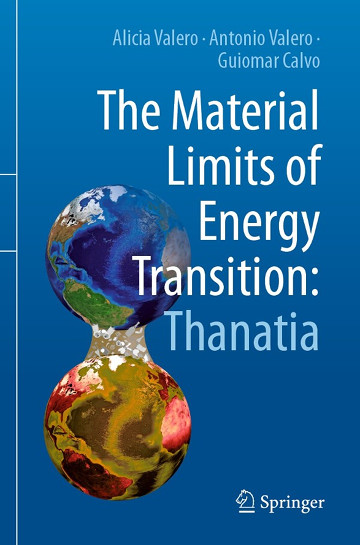(Originally published in Spanish in issue number 156 of Papeles magazine, under the title “Crisis energética”. Translated by Steven Johnson & Amelia Burke, and reviewed by Manuel Casal and the author.)
Capitalist growth, not environmental limits, is the root cause of the energy crisis
Over the long history of humanity a wide variety of political, economic, and cultural systems have been developed. Most of these have been able to satisfy human needs with a low level of consumption of materials and energy. Only capitalism has exhibited an unrestrained need for growth which has brought about an unprecedented collision with environmental limits.[1] One manifestation of that is the energy crisis.
The need of capitalism to constantly grow derives from the fact that economic entities need to be competitive in order to survive. If they are not, the companies go bankrupt or are taken over by others, and people lose their jobs and, with them, their ability to meet their needs (since in capitalism we have lost access to our own means of production by which we could provide for ourselves without needing wages to survive).
It is not only a matter of need, but of ability. There were other systems in the past that sought to grow (though nothing like capitalism). But in all of those economies, wealth had a material base (lands, cattle, gold, etc.), which limited their ability to grow. This changes with capitalism, because money can reproduce itself, at least in an illusory manner, partially without connection to the physical bases of the planet.
To achieve that continual growth, capitalism has periodically undergone mutations that have freed itself from past constraints. It is difficult to put any of these in reverse, because to do so would decrease the ability of capital to reproduce itself. Probably the most important of these mutations has been the transition from renewable energies to fossil fuels as its energy base.[2] Fossil fuels gave capitalism an unprecedented capacity to grow:

Oil well at Okemah, Oklahoma, 1922. Source: Wikimedia Commons.
- They are a very concentrated source of energy, with a high energy density, which means that it can provide a lot of energy with little mass and volume. And this enables it to have a high energy return on energy invested (EROI), that is, a high ratio of the amount of energy it provides to the amount of energy that is invested in obtaining it.
- They are available in the form of stock. This is very important, because it allows their availability to be independent of natural cycles (circadian, seasonal, life, etc.). And this also relates to why they are easy to store and transport.
- Until now, they have been available in great quantities.
- They are an energy (and material) source with multiple uses, which gives it an historically unprecedented versatility.
As we know, fossil fuels are not renewable, and are therefore limited. The limit that matters to our economy is not the quantity of reserves but the rate at which those reserves can be extracted. The concept of peak extraction is therefore crucial. In the exploitation of a mineral resource, the first stage follows a rising curve. It is a period in which ever greater amounts of the raw material can be obtained over time. It is in this stage that the largest and most easily accessed fields are found. But, inevitably, there comes a moment in which the extractive capacity begins to decline. This turning point is the peak of the substance. During this second stage, the substance is obtained in decreasing quantities. And it is of lower quality, since the sites that were largest and easiest to exploit were chosen first, and now the substance becomes harder and harder to extract. In this way, as the peak of production is passed, what remains is decreasingly available, of lower quality, and it is more technically difficult, costs more money, and requires greater investments of energy, to obtain. It also requires methods which are more polluting and therefore require more remediating measures.
All of this exerts upward pressure on the price of the raw material, so long as demand for it is maintained, until it hits the ceiling of prices that buyers can afford to pay. Likewise, the reduced ability to control how much of the material is put on the market at any given time gives rise to speculation, which is amplified by the functioning of the financial markets. This creates a scenario of wide fluctuations between high and low prices. The high prices lead the global economy into recession, while the low prices are below the cost of extraction, creating great uncertainty for the extractive companies, which withdraw their investments.

French ex-minister Yves Cochet at a conference on Peak Oil, 2007. Photo: Guillaume Paumier. Source: Wikimedia Commons.
The peak of extraction has to do with geology and is calculated using data from resources or from reserves.[3] But the question of when the peak arrives also depends on other kinds of factors: political (state subsidies, instability), economic (levels of investment, economic crises), social (opposition to extractive projects), environmental (lack of necessary conditions for extraction), and technological (improved machinery). Some of these factors are included in the calculation if reserves are used, but others are not. In any case, all of these factors influence when the peak is reached and, above all, how the decline in extraction will be experienced once the peak is passed. That is to say, the peak of extraction of a given substance depends on geological factors, but also on social factors: economic, technical, political, and cultural. From beginning to end, the use of fossil fuels in capitalism has been profoundly influenced by economics, not just physics and chemistry.
We have likely already passed the peak of petroleum production, since it has gone down since 2018. And we will likely pass the peak of coal and gas production in the next few years, if we have not passed it already. We are also past the peak of uranium production.[4] What is important is not the exact moment in which the peak occurs, but that it has happened, or soon will happen, during these historically crucial years in which we are living.
So the energy crisis is due not to the exhaustion of fossil fuels by itself, but to a system that is poorly adapted to the characteristics of the biosphere, from which it cannot escape. The energy crisis is not external to our socioeconomic system. Rather, it is a consequence of that system.
The hyper-technological renewable energies[5] are not the solution to the energy crisis
In the face of the energy crisis, which in reality is a crisis of the system, it is thought that renewable energies will be able to support capitalism’s need for continual growth. But this will not be the case, because there are environmental, technical, and socioeconomic limits to their deployment.
Let’s begin with the environmental limits. The greater part of the renewable energies are of solar origin. In the case of photovoltaic and thermic solar this is evident, but it is no less the case with wind, hydraulic, and biomass, because all of these are nothing other than transformed solar radiation. Human beings and animals, when they act as energy vectors, also do this by means of solar energy, since this is the ultimate source of all of our food.
The problem for capitalism, but not for humanity and even less for other living things, is that the properties of solar energies (to which we can add geothermal and tidal energy) are almost the opposite of the properties of fossil energies:
Wind turbines at Findhorn ecovillage. Photo: W. L. Tarbert. Source: Wikimedia Commons.
- A large quantity of solar energy falls on the surface of the earth, but it is very diffuse. This means a low EROI, since a considerable amount of energy must be invested in concentrating the solar radiation in its various forms. Large amounts of land must also be used, and, ultimately, large demands on ecosystem functions must be made, to obtain an appreciable amount of energy. There would just be one exception: hydraulic energy, since it is nature, by means of orography, that does the work of concentrating the energy. In any case, hydraulic energy only comes close to fossil energies when we are talking about large-scale hydraulic which, as we shall see, has other limits.
- Solar energies function as flows, not as stock. And so they are hard to store. Further, these flows are irregular, following circadian, seasonal, and, what is the worst for capitalism, stochastic rhythms. As a result of this, they have low capacity factors[6], and therefore many wind and solar farms must be installed in several places so that, when some are not producing, others are, and so compensate each other. And we must rely on batteries for storage, but these require a great deal of energy to produce. Biomass and hydraulic energy (making use of reservoirs) are a partial exception, since they can function as stock, but always in quantities that are considerably lower than the fossil energies.
- Renewables, even in a best case scenario, would provide half of the energy of fossil energies[7]. In reality, what matters is not the energy, but the power, in that renewables have still more problems due to their low energy density. But the best case scenario will never occur because life also demands solar energy. Ecosystems require this energy for their homeostasis, and, to put it simply, we cannot endlessly remove it from the ecosystems because we are eco-dependent.
The hyper-technological renewables use high technology devices that convert the various energies of solar origin into electricity. This technology has some additional limits for replacing fossil fuels. And so we come to the second category of limits, the technical ones.
Electric energy generation accounts only for a relatively small fraction of total world energy consumption. Source: EIA and Labyrinth Consulting Services, Inc.
Electricity comprises approximately only 20% of our energy consumption. The 80% remaining is not electrified. And the problem is not just that it is not electrified, but that it would be extremely difficult to make it so. This is obvious in the petrochemical sector, and especially in the transport sector. In the first place, because we do not have technology that can move heavy vehicles of high cargo capacity and autonomy of movement with electric batteries (for example, trucks). But even in what we do have technology for (vans and smaller vehicles), the challenge is gigantic. Not even 1% of the fleet of vehicles is electrified, and to electrify much more of it would require an investment of energy (from fossil fuels, let’s not forget), materials, time, and money that is beyond our capacities[8].
The alternatives that are put forward are biofuels and hydrogen, but, in addition to other problems, both of these energy vectors have very low net energy. It takes a large investment of energy to obtain very little.
This is no minor issue, since transport is utterly crucial to our socioeconomic order. Without rapid mobility of large masses of freight over long distances, which is what petroleum allows, there would be neither modern cities nor globalization.
The second problem of a technical nature is that what we call renewable energies are not really renewable. To build dams, wind generators, and solar panels, fossil fuels are used. They are used in the process of extraction of the needed resources (for example, in the heavy machinery used in mining), in manufacture (for example, of concrete), in distribution (which is done via global value chains), and in installation and dismantling (heavy machinery is needed yet again). But it is not only that these fuels are being used. It is also that there is no technology that would enable us to stop using them. From this perspective, it can be said that the hyper-technological renewables are an extension of fossil fuels.
Book by Valero, Valero and Calvo on mineral limits to Energy Transition, published by Springer, 2021.
The problem also lies in materials. The high performance of the hyper-technological renewables depends on elements that in many cases are in short supply in the earth’s crust, and are simply not available in the quantities that the maintenance of capitalism requires. This would be the case with tellurium, indium, tin, silver, gallium, and lithium[9].
Moreover, the lifespan of the hyper-technological renewables is relatively short, from 25 to 40 years in the case of wind and solar, and somewhat longer in the case of hydraulic. This makes them a very poor alternative since, when they start to break down, the availability of fossil fuels and minerals will have decreased by a significant amount, making it impossible to replace more than a small percentage of their installed capacity.
With regard to socioeconomic limits, the first point to consider is that the hyper-technological renewables are serving, not the energy transition, but the reproduction of capital. This is made evident in various ways: By the hierarchical control of these technologies, a control that is in the hands of the oligarchy that dominates their production and commercial development; the technology is not one of social access. By the coloniality of their deployment, in that they are located in sacrifice zones. This lies behind conflicts that are being generated between centers and peripheries, at state and international levels. By the unjust ways in which markets allocate the uses of the electricity that is produced, which is one of the causes of energy poverty. And, ultimately, because the spread of these technologies is pursued only to make money, as is shown by the lack of planning in their current development, which has all the characteristics of an economic bubble.
But even though these technologies’ purpose is to further the reproduction of capital, they cannot really sustain it, due to their distinct properties from those of fossil energies. It is not surprising, then, that models are forecasting that their massive deployment will not avoid a significant fall in world GDP[10].
Further, the fact that they serve the reproduction of capital turns them into capital. Or, in other words, they can only be developed if capitalism goes well, if it continues growing. For this reason, the crisis of capitalism also means the crisis of the hyper-technological renewables.
‘La Escondida’ in Chile, largest copper mine in the world. Photo: Antofagasta Municipality. Source: Wikimedia Commons.
In the environmentalist movement it is commonly suggested that the hyper-technological renewables serve as bridge to others that are really renewable, making the process of change easier to accept, socially and economically. It is one of the arguments used by defenders of a Green New Deal with an emancipatory vision. The problem is that we are no longer in the 1980s or 1990s, when such a transition in two stages could have been viable.
At this time we are witnessing the collapse of the present order, as shown by the proliferation of completely exceptional phenomena in recent months all over the world (pandemic, deep economic crisis, especially virulent fires, shortages of numerous materials, the proliferation of extreme weather events, diseases, etc.). We are no longer looking at a coming systemic collapse that we might avoid. Rather, we are already living in the midst of it.
Not only that, but the peak of fossil fuels and of many materials prevents us from being able to use these resources to accomplish a transition in two stages. And, even more importantly, the United Nations says that emissions must be reduced, without delay, by 7.6% per year[11]. But a massive buildout of the hyper-technological renewables requires an unacceptable increase in emissions over the short term[12]. It cannot be otherwise, considering the massive amount of industrial production it involves.
While the climate emergency and the ecosystem emergency both require urgent action, the latter affords us even less time to spare. In the case of the climate emergency, the development of the hyper-technological renewables means an improvement in the mid-term (emissions increase at first, but decrease later). But in the case of preserving biodiversity there is not even that. The expansion of hyper-technological renewables is already hindering protection of the environment, as shown by mining[13], and this conflict will grow over time.
That being the case, and since human beings are eco-dependent, there can be no such transition in two stages. It will need to be accomplished in one movement, which rules out the hyper-technological renewables as the means. This is another of their socioeconomic limits.
Resolving the energy crisis requires a change of system
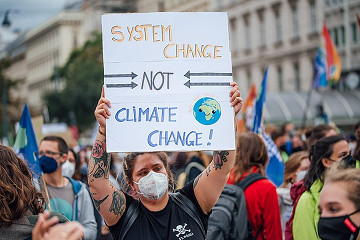
Climate protests in September of 2021. Photo: Ivan Radic. Source: Wikimedia Commons.
If the hyper-technological renewables are not the solution to the energy crisis, what should we look to instead? What is proposed here is to rapidly develop renewable energies that are really renewable, and that are also emancipatory. Such really renewable and emancipatory energies (hereafter, RR+E energies), have the following characteristics:
First, the RR+E energies are built with renewable energy and materials. The primary inspiration comes from plants, which use solar energy by means of photosynthesis, but also to draw the sap to the leaves. The technical working of plants is a marvel of nature. They grow and repair themselves, function at ambient temperature, and use materials that are abundant. They generate and maintain a patterning of life that virtually enables them to close the cycles of materials (the recycling rates of nitrogen, carbon, and phosphorous reach values in the order of between 99.5 and 99.8%[14]). Along these lines, the materials used in the RR+E energies are biomass, materials that are abundant and easily recyclable, and that can be obtained using renewable energies, as is the case with iron, and those which do not need to be purified, such as granite.

Japanese water mill at Onden, xilography by Katsushika Hokusai (c. 1830). Source: Wikimedia Commons.
Second, the RR+E energies perform direct work, not just generate electricity. That is, they pump water from below the ground, or mill grain. We need engineering developments that apply the knowledge generated over the last decades to give a qualitative leap to the renewable energies that were used in preindustrial times and in the first decades of the Industrial Revolution, such as hydraulic mills. Along these lines, human beings and animals will likely need to again become some of the key energy vectors, due to our multifunctionality.
Third, the RR+E energies are harmoniously integrated into the functioning of ecosystems. What is more, they rely on the functioning of the ecosystems without which they cannot be developed. Their logic is therefore not of leaving areas free of these natural workings, nor of environmental impact statements, dynamics which are necessary for the hyper-technological renewables due to the fact that they do not function within the web of life.
In this regard, an example of an RR+E energy is sail navigation, which uses sea winds, which are more regular than those on land, to travel. Hydraulic mills use the potential energy found in the flow of water down rivers, together with the concentration of water that is received at the bottom of the valley. Bioclimatic construction takes advantage of the sun, orientation, and currents for cooling and heating, making use of local materials. Permaculture and food forests are based in ecosystemic balances to feed (provide energy to) people and many other living beings.

Image on the reverse of a commemorative dollar coin with a tribute to native American agriculture, representing ‘the three sisters’. Design by Norman Nemeth. Source: Wikimedia Commons.
Fourth, the RR+E energies abide by the principle of honorable harvest[15]. This is a concept used by North American Indigenous populations to pursue a twin goal: On the one hand, to leave enough for the rest of living beings. That is, to not hoard all of the solar energy. Nor even a significant portion of that energy, since this is crucial for the functioning of ecosystems. On the other hand, honorable harvest seeks not only to leave enough for the rest, it also seeks to favor the growth of life, for example, by taking wood from the forests by means of a thinning that enables the regeneration of arboreal mass and other types of vegetation, thus enriching the ecosystem.
An important implication of the principle of honorable harvest is that it will not be possible to maintain the guarantee of the current level of energy supplied, since large quantities of energy would not be hoarded. And this means that societies will have to prioritize which are the most important things for which to maintain a guaranteed energy supply (for example, a medical center or a community refrigerator), and which other uses of energy will have to adapt to natural rhythms. This is not to say that there can be no storage, for example, with wood or hydraulic dams, but that these energy stores will guarantee the supply better the less consumption there is.
Finally, the RR+E energies are controlled by communities. Control over both the uses and the technic. This is the only way they can be technologies characteristic of genuinely democratic and just societies. This means simple, local technics involving nearby materials and energy sources.
It is plain to see that the RR+E energies are not compatible with capitalism, which has hybridized itself with the fossil energies and uses the hyper-technological renewables as a crutch. And so an important conclusion is that there is no energy transition without political, economic, and cultural transition. The energy crisis cannot be resolved without changing the system.
Conclusions
Without a doubt, the hyper-technological renewables are preferable to fossil and nuclear energies, as their socio-environmental impacts are qualitatively and quantitatively lower. But these energies are tied to the functioning of capitalism. Further, we are experiencing the peaks of extraction of fossil fuels and various elements, together with the climate and ecosystem emergencies (with all their implications). This means that these energies do not even buy us time, especially if we take a holistic look (impacts on biodiversity, use of materials, coloniality, etc.). For this reason, we need to achieve radical changes in both social and energy systems at the same time. There are no shortcuts.
This is very complicated, but the complication is not in moving toward really renewable energies, which will happen in any case, no matter how tortuous the road may become. The challenge lies in steering the transition towards really renewable energies that are, in addition, emancipatory (RR+E).
The journey will be made while our current system is falling apart. When an old order breaks down, others emerge, and amid that chaos, new opportunities will open up for us if we have enough collective organizing capacity. We will face the difficulty of having no time to plan the transition. But there will also be cracks in the mechanisms of social control that we can take advantage of.
In order for new worlds, driven by the RR+E energies, to emerge, it is essential to build concrete projects that set them in motion. Without such projects, the transition will simply be impossible. But for these projects to take off, it is necessary to promote social imaginaries that make the RR+E energies visible. There are already plenty of economic and political actors defending the hyper-technological renewables. The time has come to shift our discourses toward technics that will enable us to change the energy matrix while also achieving an ecosocial transition.
Notes
[1] Ramón Fernández Durán and Luis González Reyes, En la espiral de la energía (Madrid: Libros en Acción y Baladre, 2018).
[2] Andreas Malm, Fossil Capital: The Rise of Steam Power and the Roots of Global Warming (London: Verso, 2016).
[3] Resource refers to the quantity of a compound whose extraction is technically possible or might become possible. The portion of that resource which is legally and economically extractible is the reserve.
[4] Antonio Turiel, Petrocalipsis: Crisis energética global y cómo (NO) la vamos a solucionar (Madrid: Alfabeto Editorial, 2020).
[5] Sources of energy (sun, wind, petroleum), energy vectors (electricity, gasoline, human beings), and technologies used to take advantage of the sources (wind turbines, solar panels) are commonly intermingled in writings on these topics. This text follows this intermingled usage, since when we speak of the hyper-technological renewable energies, on the one hand, and of the truly renewable and emancipatory ones (see further below), on the other hand, we are really speaking more about the technologies used to take advantage of the renewable energies (and for that reason about something that is not extra-human) than about the energies themselves.
[6] Capacity or load factor is the ratio of the real energy generated by a power plant during a period (generally annual) to the energy that it would have generated if it were working at full capacity. See Bolson, Natanael, Pedro Prieto, and Tadeusz Patzek, “Capacity Factors for Electrical Power Generation from Renewable and Nonrenewable Sources,” Proceedings of the National Academy of Sciences 119, no. 52 (2022), https://doi.org/10.1073/pnas.2205429119.
[7] Fernández Durán and González Reyes, Espiral.
[8] Pedro Prieto, “Consideraciones sobre el coche eléctrico y la infraestructura necesaria,” 15/1515, April 19, 2019, https://www.15-15-15.org/webzine/2019/04/19/consideraciones-sobre-el-coche-electrico-y-la-infraestructura-necesaria/.
[9] Capellán-Pérez, Iñigo, Carlos de Castro, and Luis Javier Miguel González, “Dynamic Energy Return on Energy Investment (EROI) and Material Requirements in Scenarios of Global Transition to Renewable Energies,” Energy Strategy Reviews 26 (2019), https://doi.org/10.1016/j.esr.2019.100399.
[10] Jaime Nieto, Óscar Carpintero, Luis Javier Miguel, and Íñigo de Blas, “Macroeconomic Modelling under Energy Constraints: Global Low Carbon Transition Scenarios”, Energy Policy 137 (2020), https://doi.org/10.1016/j.enpol.2019.111090.
[11] The Emissions Gap Report 2019, Nairobi, Kenya: United Nations Environment Programme, 2019, https://www.unep.org/resources/emissions-gap-report-2019.
[12] Nieto et al., “Macroeconomic Modelling.”
[13] Laura J. Sonter, Marie C. Dade, James E. M. Watson, Rick K. Valenta, “Renewable Energy Production Will Exacerbate Mining Threats to Biodiversity,” Nature Communications 11, no. 1 (2020), DOI: https://doi.org/10.1038/s41467-020-17928-5.
[14] Carlos de Castro, Reencontrando a Gaia: A hombros de James Lovelock y Lynn Margulis, Málaga: Ediciones del Genal, 2019.
[15] Robin Wall Kimmerer, Braiding Sweetgrass: Indigenous Wisdom, Scientific Knowledge and the Teachings of Plants, Minneapolis: Milkweed Editions, 2013.


